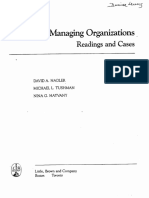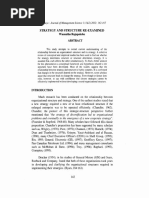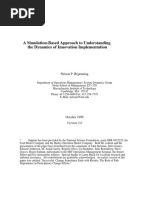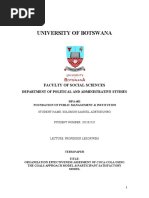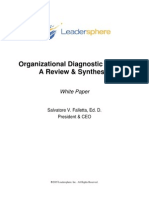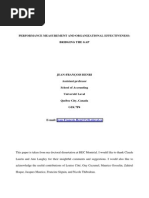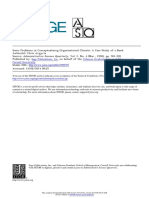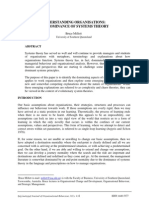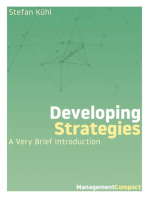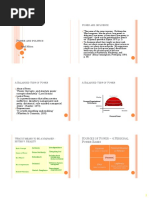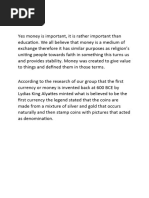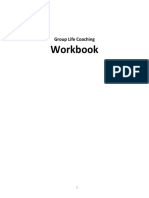A Spatial Modle of Effectiveness Criteria
A Spatial Modle of Effectiveness Criteria
Uploaded by
m_malhanCopyright:
Available Formats
A Spatial Modle of Effectiveness Criteria
A Spatial Modle of Effectiveness Criteria
Uploaded by
m_malhanCopyright
Available Formats
Share this document
Did you find this document useful?
Is this content inappropriate?
Copyright:
Available Formats
A Spatial Modle of Effectiveness Criteria
A Spatial Modle of Effectiveness Criteria
Uploaded by
m_malhanCopyright:
Available Formats
MANAGEMENT SCIENCE
Vol. 29, No. 3, March 1983
Printed in U.S.A.
A SPATIAL MODEL OF EFFECTIVENESS CRITERIA:
TOWARDS A COMPETING VALUES APPROACH TO
ORGANIZATIONAL ANALYSIS*
ROBERT E. QUINNf AND JOHN ROHRBAUGHf
This paper presents a framework for organizational analysis. The empirically derived
approach does not emerge from the observation of actual organizations, but from the ordering,
through multivariate techniques, of criteria that organizational theorists and researchers use to
evaluate the performance of organizations.
In a two-stage study, organizational theorists and researchers were impaneled to make
judgments about the similarity of commonly used effectiveness criteria. The model derived
from the second group closely replicated the first, and in convergence suggested that three
value dimensions (control-flexibility, internal-external, and means-ends) underlie conceptualizations of organizational effectiveness.
When these value dimensions are juxtaposed, a spatial model emerges. The model serves a
number of important functions. It organizes the organizational effectiveness literature, indicates which concepts are most central to the construct of organizational effectiveness, makes
clear the values in which the concepts are embedded, demonstrates that the effectiveness
literature and the general literature on organizational analysis are analogues of one another,
and provides an overarching framework to guide subsequent efforts at organizational assessment.
(ORGANIZATIONANALYSIS, EFFECTIVENESS)
Deeply embedded in the organizational literature is the construct of effectiveness.
Improved effectiveness, for example, is claimed as the desired end in the applied fields
of organization development [10] and organization design [16]. At the theoretical level,
Goodman and Pennings [12] have argued that effectiveness is the central theme in all
of organizational analysis and that it is difficult to conceive of a theory of organization
that does not include the effectiveness construct.
While effectiveness is clearly a construct of central importance, it is not without
problems. One of the major problems pertains to the elusiveness of a definition. In a
major review of the effectiveness literature, Campbell [8] was able to identify 30
different criteria of effectiveness. The imprecise definitions and conceptual overlap
between the 30 criteria led Campbell to conclude:
. . . different people adhere to different models, and there is no correct way to choose among
them. Thus, when a Hst is put together from different conceptual points of view, the composite
list will almost inevitably look messy. [8, p. 40]
Observations such as this one are part of an increasing disillusionment with the
effectiveness construct. Steers [33] has questioned the value of the construct, and
Hannan and Freeman [14] have severely criticized it. More recently, Bluedom [3] has
argued that the construct should be entirely eliminated. While some disagree with the
call for a moratorium on studies of organizational effectiveness [30], [7], nearly all
would agree that the effectiveness literature is in disarray.
While there are many reasons for the confusion [6], there is one that is of particular
importance to this study: the fact that effectiveness is not a concept but a construct. A
Accepted by Arie Y. Lewin; received July 7, 1981. This paper has been with the authors 3 months for 1
revision.
State University of New York at Albany.
363
0025-1909/83/2903/0363$01.25
Copyright 1983, The tnstituic or Managemenl Sciences
364
ROBERT E. QUINN AND JOHN ROHRBAUGH
concept is an abstraction from observed events, the characteristics of which are either
directly observable or easily measured. Some concepts, however, cannot be so easily
related to the phenomena they are intended to represent. They are inferences, at a
higher level of abstraction from concrete events, and their meaning cannot easily be
conveyed by pointing to specific occurrences. Such higher-level abstractions are
sometimes identified as constructs, since they are constructed from concepts at a lower
level of abstraction. The problem is that no one seems to be sure which concepts (such
as productivity or capital growth) are to be included in the construct of effectiveness,
or how they are to be related [7], [33]. The highly abstract nature of the construct and
the lack of agreement as to its structure accounts for a major portion of the confusion
in the effectiveness literature.
Given divergent perspectives and emphases in the organizational literature, what is
necessary in order to clarify the construct of organizational effectiveness? Steers [33]
suggested that the first step should be to identify ali of the variables in the domain of
effectiveness and then to determine how the variables are similarly related. Campbell
[8] proposed a similar approach. As mentioned above, he identified a comprehensive
list of 30 criteria; he pointed out that the list of variables was long and varied in
generality, methods of operationalization, and closeness to the final payoff; and he
stressed the need to "weed out the overlap and get down to the core variables" [8, p.
39].
Scott [29], Seashore [30], and Cameron [5] have all attempted to bring some
integration to the literature. Scott [29, pp. 73-74], for example, has suggested that the
numerous criteria of effectiveness can be reduced to three basic models: the rational
system model, natural system model, and open system model. According to Scott, the
emphasis of the rational system model, due to its mechanistic, instrumental bias, is on
the number of units produced in a given time (productivity) and the number of units
produced for a given number of input units (efficiency). The natural system approach
considers not only the production function, but also the activities required for the unit
to maintain itself. From this organic view, attention is focused on such properties as
morale and cohesion. The open system model includes system-elaborating as well as
system-maintaining functions. The activities emphasized by this model are adaptability
and resource acquisition.
Seashore [30] has also suggested a three-model integration of the effectiveness
literature. His goal model is very similar to Scott's rational model, but he has used the
natural system model to cover both the natural and open system approaches described
by Scott. His third model, the decision process model, is unlike any of the models
proposed by Scott. In the decision process model, the effective organization is the one
which "optimized the processes for getting, storing, retrieving, allocating, manipulating, and discarding information."
Cameron [5] has proposed a four-model integration of the literature. These four
models are the goal, systems resource, internal processes, and participant satisfaction
approaches. The goal model is very similar to the rational or goal models described by
Scott and Seashore. The system resource model is very similar to Scott's open system
model, while the internal process model parallels Seashore's decision process model.
Cameron's last model, the participant satisfaction or strategic constituency model, is
an elaboration of the natural system model mentioned by both Scott and Seashore.
Here the organization is seen as a dynamic coalitional entity within which complex
transactional networks of constituencies develop. The effective organization must
satisfy each constituency enough tbat continued transactions are assured.
These three attempts to integrate the effectiveness literature reflect both consensus
and disagreement. There seem to be several well-identified themes running through the
A SPATIAL MODEL OF EFFECTIVENESS CRITERIA
365
effectiveness literature, yet each theorist offers an integration that differs somewhat
from each of the others. While their agreement is considerable, the construct of
effectiveness as it has been employed is certainly "fuzzy" enough to generate the
apparent divergencies as to which concepts belong in the construct, how they relate to
each other, and what particular clusters of concepts should be called.
Neither have traditional multivariate methods been particularly appropriate for
solving the problem at hand. The shortcomings of such approaches have been noted
by Campbell [8], who was particularly pessimistic about the pitfalls of factor analytic
studies. Assembling a large sample of organizations, measuring a set of potential
criteria, and then reducing them through factor analysis is a process the outcome of
which is highly dependent upon the initial task of selecting measures. Whenever an
organization is to be evaluated, investigators must consciously choose a precise set of
criteria upon which to base their assessments. In organizational research, these criteria
traditionally have been either selected and then imposed upon the organization by the
researchers or evaluators themselves, or they have been derived from interviews with
members of the target organizations. In either case, the selected criteria usually reflect
an unarticulated but fundamental set of underlying personal values about the appropriate emphases in the domain of effectiveness. These personal values that motivate
the choice of particular criteria ultimately underlie the resulting effectiveness dimensions "uncovered" by (but actually antecedent to) factor analytic studies.
The method of investigation used in the present study, although multivariate, was a
radical departure from previous factor analytic efforts employed to derive dimensions
of organizational effectiveness. The focus was on the cognitive structure of the
organizational theorist, not on the operational structure of the organization. Here we
provide a method for making the implicit and abstract notions of multiple theorists
and researchers explicit and precise. The question posed was, "How do individual
theorists and researchers actually think about the construct of effectiveness?" The
procedure described in the following sections uses multidimensional scaling to approach the problem. The present paper emerges from an initial exploratory study
employing a panel of 7 experts [23] and a second study in which a larger group of 45
theorists and researchers participated.
1. Initial Exploratory Study
Participants
Seven individuals who had research interests in the area of organizational effectiveness participated in the initial exploratory study. Six of the seven had presented or
published papers on the topic. All of the participants held doctorates; each degree was
earned at one of seven different institutions. The participants represented a diverse
array of academic backgrounds and interests including sociology, business, industrial
psychology, public administration, social psychology, and organizational behavior. At
the time the study was conducted, the panel members were employed in five different
academic departments and a national research foundation.
Procedure
Campbell's [8] list of 30 indices of oganizational effectiveness was selected as the
basis of the study for several reasons. First, it was generated by a major review of the
relevant literature with the stated intent of providing a comprehensive compilation of
effectiveness criteria. Furthermore, the list of indices was supplemented with generally
explicit definitions of each particular term or phrase. Finally, Campbell's paper which
366
ROBERT E. QUINN AND JOHN ROHRBAUGH
contains the list had become a widely cited article in the literature on organizational
effectiveness and, therefore, the list was increasingly the focus of attention.
The seven panel members were asked to participate in a two-stage judgment task in
order to reduce and organize the list of 30 criteria. In the first stage, participants were
asked to apply four decision rules for eliminating any criterion which was (1) not at the
organizational level of analysis; (2) not a singular index but a composite of several
criteria; (3) not a construct but a particular operationalization; or (4) not a criterion of
organizational performance. These rules were generated for methodological reasons
cited specifically by Campbell [8], who admitted that the 30 criteria were varied in
generality, operationalization, and closeness to the final payoff {for details, see Quinn
and Rohrbaugh, [23]).
In the second stage, participants were asked to evaluate the .similarity between every
possible pairing of the remaining criteria through a systematic sequence of comparison
judgments made on a rating scale of 1 (very dissimilar) to 7 (very similar). Emphasis
was placed on the instruction that the judgments were to be based solely upon the
conceptual similarity or dissimilarity of the criteria rather than upon the likelihood
that the two criteria would covary across organizational settings or across time. This
set of similarities judgments was then subjected to multidimensional scaling in order to
identify the dimensions of organizational effectiveness that underlay the comparison
ratings provided by the participants. Although the early work in the development of
multidimensional scaling involved strictly within-subjects designs (where multiple
judgments of single individuals were analyzed for cognitive structure), more recent
techniques have been designed to incorporate inter-stimulus proximities from several
participants (for example, see Romney, Shepherd, and Ncrlove [27]; Shepherd, Romney, and Nerlove [31]). Such models assume that there is a psychological space shared
by all individuals, but that each individual stresses different aspects of the stimuli
while making judgments. Thus, one of the critical issues in multidimensional scaling is
that sampling of stimuli (in this case, criteria of effectiveness) be representative of the
larger population of stimuli, rather than the more widely accepted norms of sampling
participants as required for between-subjects research designs.
Results
The purpose of the first stage of the judgment task was to reduce the list of
effectiveness criteria to contain only singular constructs pertaining to performance
evaluations of organizational units. Ehmination of a criterion required agreement in
the judgments of at least six or seven panel members. The requirement of agreement
among at least six of the panel members in order to eliminate a criterion from further
consideration was clearly a conservative procedure, erring on the side of overinclusion. That is, even if five of seven panel members felt that a criterion should be
eliminated, it remained in the analysis. Of the 30 original criteria, 13 criteria were
eliminated by six or seven panel members (for details, see Quinn and Rohrbaugh [23]).
Each panel member made judgments of the similarity between every possible pairing
of the criteria not eliminated in the first stage of the study. With the panel members'
paired comparison ratings, it was possible to identify the fundamental cognitive
dimensions by which the individual judgments of relative similarity or dissimilarity
were made. The INDSCAL algorithm developed by Carroll and Chang [9] was
employed to perform the multidimensional scaling for this analysis. As in other
inultidimisioBal scaling procedures, it is assumed in INDSCAL that participants'
judgments of similarity between pairs of stimuli depend on the distances between
stimuli in an underlying psychological space common to all participants. INDSCAL
differs from other scaling techniques, however, in its assumption that individuals differ
367
A SPATIAL MODEL OF EFFECTIVENESS CRITERIA
with respect to the perceptual importance or weight of each dimension of this common
or group space. Thus, unique individual weightings of dimensions do not theoretically
interfere with the identification of the group space.
As in factor analysis, INDSCAL does not provide a clear indication of the number
of dimensions to use. Since by three dimensions the addition of reproducible variance
became negligible and the interpretability of dimensions was considerably more
difficult thereafter, it was decided to work with a solution incorporating a threedimensional space. As a criterion of goodness-of-fit of the model, the overall correlation of the distances in the three-dimensional space with the original similarities
judgments (0.72) was comparable to those found in other applications of the INDSCAL procedure to complex stimuli. All of the participants' weights on each dimension
were positive, and individual correlations of the distances with the original similarities
judgments were invariably large (the maximum correlation was 0.87 and the minimum
was 0.64), indicating considerable consensus among panel members as to the group
space. In short, the INDSCAL model appeared to fit the paired comparison data.
Figure 1 graphically depicts the three dimensions that emerged from the INDSCAL
analysis and the location of the effectiveness criteria in the multidimensional space.
The first dimension (the horizontal or x-axis) was interpreted as reflecting differing
organizational focus by representing the contrast between an internal, person-oriented
emphasis (toward the left) and an external, organization-oriented emphasis (toward the
right). The second dimension (the vertical or ^-axis) was interpreted as reflecting
differing organizational preferences for structure by representing the contrast between
an interest in stability and control (toward the bottom) and flexibility and change
(toward the top). The third dimension (a depth or distality axis) was interpreted as
reflecting the degree of closeness to desired organizational outcomes or a means-ends
QTRUCTURE:
Flexibility
-+,40
Fiexibiiity/
Adaptation O
Morale
Value of
human resources
Readiness
Growth
Training and
development emphasis
Utilization
of environment
Quality
Evaluations by
external enlitiss
Conflict/cohesion
Internol
-.40
-.20
+.20
-20
Means
Ends
OPIonning and
goai setting
information monogement
ond communication
ControlO
Stability
Control
FIGURE I
] Productivity
Efficiency
+.40
Exterroi
368
ROBERT E. QUINN AND JOHN ROHRBAUGH
continuum, by representing the contrast between a concern for ends (nearer and
larger) and a concern for means (farther away and smaller). These dimensions will be
discussed in greater detail below.
2. Primary Study
Participants
At the conclusion of the initial exploratory study, a decision was made to attempt to
replicate its results with a larger, more diverse group of active organizational theorists
and researchers. The criterion for selecting such a participant group was their publishing at least one study in Administrative Science Quarterly during a two-year period
prior to the initiation of the primary study. Administrative Science Quarterly was
selected for its pool of authors because of its centrality to the development of
organization theory, its high selectivity with respect to articles accepted for publication, and its interdisciplinary focus. This criterion tended to insure the identification of
a knowledgeable, competent, and diverse set of organizational theorists and researchers. Seventy-six authors who had published during the target period were invited to
participate; 48 agreed to participate, and 45 (a 60 percent response rate) completed the
necessary research task.
Procedure
Each of the respondents made judgments about the similarity between every
possible pairing of the 17 criteria not eliminated by the panel in the initial exploratory
study. Thus 136 paired comparisions were made by each participant. Again, the
INDSCAL algorithm was employed to perform the multidimensional scaling for this
analysis.
Flexibility
+ 40
Value of
human resources
Fiexibiiity/
Adaptation
Training and
development emphasis - +.20
Morole
/ ^ ^ Growth
\_y
Evaiuctionsby
externai entities
O
Conflict/cohesion
Internal
O,
-40
^Utilization
^ - ' of environment
Readiness
O
-.20
+.20
+40
_J
External
Profit
Planning
Goals
informatian management
and communication
Means
0
Ends
--20
Stability ^
Controi
O-
-.40
Controi
FiGtniB 2
Productivity
Efficiency
369
A SPATIAL MODEL OF EFFECTIVENESS CRITERIA
Results
The results of testing two-, three-, four-, and five-dimensional solutions to the group
judgment space again suggested a model with three axes. As in the initial analysis, the
overall correlation (0.63) of the distances in the three-dimensional space with the
original similarity judgments was high, the weights of all of the participants with
regard to each dimension were positive, and individual correlations of the distances
with the original similarities judgments were generally quite high (an average of 0.62).
The addition of a fourth dimension to the judgment space was shown to increase by
less than 5 percent the proportion of variance accounted for.
Figure 2 depicts the three dimensions that emerged from the second analysis and the
location of the 17 criteria in the multidimensional space. Most significantly, the same
three dimensions appear as before, and the criteria show only the slightest alteration in
their spatial position.
3. Discussion
An Overview of the Competing Values Approach
The findings suggest that organizational researchers share an implicit theoretical
framework and, consequently, that the criteria of organizational effectiveness can be
sorted according to three axes or value dimensions. The first value dimension is related
to organizational focus, from an internal, micro emphasis on the well-being and
development of people in the organization to an external, macro emphasis on the
well-being and development of the organization itself. The second value dimension is
related to organizational structure, from an emphasis on stability to an emphasis on
flexibility. The third value dimension is related to organizational means and ends, from
an emphasis on important processes (e.g., planning and goal setting) to an emphasis on
final outcomes (e.g., productivity). A simplified presentation of the relationship between the three value sets and the effectiveness criteria is shown in Figure 3.
OPEN SYSTEM MODEL
HUMAN RELATIONS MODEL
Flexibility
Means:
Means:
Cohesion; morale
Flexibility ; readiness
Ends:
Ends:
Human resource development
Growth; resource acquisition
External
Internal
Means:
Means:
Information management;
communication
Planning'goal setting
EndsStability; control
Ends:
Productivity;effioiency
Control
R'ATIONAL GOAL MODEL
INTERNAL PROCESS MODEL
FIGURE 3
370
ROBERT E. QUINN AND JOHN ROHRBAUGH
These three sets of competing values are recognized dilemmas in the organizational
literature [1]. The emergence of the one pair of competing values, flexibility versus
stability, reflects a basic dilemma of organizational life. The differing viewpoints in
considering order and control versus innovation and change are at the heart of the
most heated debates in sociology, pohtical science, and psychology. While many social
theorists have emphasized authority, structure, and coordination, others have stressed
diversity, individual initiative, and organizational adaptability. Lawrence and Lorsch
[17] centered their landmark study around this dilemma and argued that integration
and differentiation were the core issues in the history of organizational design. The
findings from their study were used to suggest that those organizations that are able to
best balance integration and differentiation are also the most effective systems. Others
have made similar arguments [1].
The next pair of competing values, internal versus external, represents another basic
dilemma of organizational life. From the external view, the organization is a logically
designed tool with the ultimate goal of accomplishing its tasks and acquiring resources.
Here the emphasis is on the overall competitiveness of the organization in sometimes
changing environments. From the internal view, the organization is a socio-technical
system. Participants have unique feelings, likes and dislikes, and require consideration,
appropriate information, and stability in their workplace. When the external value on
the overall organization is maximized, the internal emphasis on the socio-technical
equilibrium may be reduced; and when the emphasis on internal harmony grows, it
may tend to shift emphasis away from overall competitiveness. This dilemma also has
been long recognized in the literature on organizational behavior [13], [1], [17].
The last basic organizational dilemma reflected by the third set of competing values,
means versus ends, was well stated by Georgopoulos and Tannenbaum [11]:
It is our assumption that all organizations attempt to achieve certain objectives and to develop
group products through the manipulation of given animate and inanimate facilities. Accordingly, definitions of organizational effectiveness must take into consideration these two
aspects: the objectives of organizations and the means through which they sustain themselves
and attain their objectives, particularly those means that usually become functionally autonomous (i.e., that come to assume the character of and function as organizational goals). In
short, the study of organizational effectiveness must contend with the question of organizational means and ends.
In the world of administration, the means-ends dilemma is a difficult problem.
Lawrence and Lorsch [17, p. 35] discuss this difficulty in terms of conflicting time
horizons, while Katz and Kahn [15, p. 252] point out the difficulty of balancing means
and ends at some optimum point.
While each of these three continua has been recognized individually and discussed
as problems for managers to solve, they have never before been identified as integrated
elements of a single conceptual framework. The three-dimensional integration of these
continua makes possible the identification of four basic models of organizational
effectiveness.
Four Middle Range Models of Organizational Analysis
It has been argued that the effectiveness literature represents the central theme in
organization theory [12, p. 2]. We agree with this statement, and would further argue
that the literature on organizational effectiveness is simply a grounded version of the
literature on organizational analysis. Consider, for example, the three attempts at
integration that were discussed earlier [29], [30], [5]. When the results of the multidimensional scaling in the present study are carefully examined, it becomes clear that the
A SPATIAL MODEL OF EFFECTIVENESS CRITERIA
371
separation of the 17 effectiveness criteria in the three-dimensional space graphically
defines four models and brings considerable precision to the development of a
construct of effectiveness. In naming the four models, we have attempted to maintain
a continuity with the intuitive attempts described above [29], [30], [5].
The human relations model places a great deal of emphasis on flexibility and
internal focus, and would stress such criteria as those shown in the upper left section of
Figure 3: cohesion and morale (as means) and human resource development (as an
end). The open system model places a great deal of emphasis on flexibility and
external focus, and would stress such criteria as those shown in the upper right section
of Figure 3: flexibility and readiness (as means) and growth, resource acquisition, and
external support (as ends). The rational goal model places a great deal of emphasis on
control and external focus, and would stress the effectiveness criteria shown in the
lower right section of Figure 3: planning and goal setting (as means) and productivity
and efficiency (as ends). The internal process model is represented in the lower left
section of Figure 3. It places a great deal of emphasis on control and internal focus,
and would stress the role of information management and communication (as means)
and stability and control (as ends). This model would commend an orderly work
situation with sufficient coordination and distribution of information to provide
organizational participants with a psychological sense of continuity and security.
Because each model is embedded in a particular set of competing values, it has a
polar opposite model with contrasting emphases. The human relations model with its
effectiveness criteria reflecting flexibility and internal focus stands in stark contrast to
the rational goal model's value-based stress on control and external focus. The open
system model based on flexibility and external focus runs counter to the internal
process model, the effectiveness criteria of which reflect a focus on control and
internal focus. Parallels among the models are also important. The human relations
and open system models share an emphasis upon flexibility. The open system and
rational goal models are primarily concerned with an external focus. The rational goal
and internal process models are rooted in a value on control. Finally, the internal
process and human relations models share an internal focus.
Another interesting characteristic of the four models is their degree of differentiation. Of all possible combinations of the four models, the two that are most similar
are the internal process model and the rational goal model. This nearness in cognitive
space is depicted in Figures 1 and 2, which show these two models are not as
differentiated on the internal-external dimension as are the human relations and open
system models. While the internal process model is more internal and the rational goal
model is more external, they are conceptually close to one another. This may help to
explain why we have only recently seen the internal process model identified separately from the rational goal model (compare Scott [29], Seashore [30], Cameron [5]).
It is also interesting to note that one criterion, output quality, is an isolate in the
three-dimensional space shown in Figures 1 and 2. While it somewhat reflects a value
on flexibility, it is nearly neutral on the other two value dimensions. When a
hierarchical cluster analysis was performed, output quality was last to be grouped with
any of the other effectiveness criteria. This suggests that output quality does not fit
into one particular model of organizational effectiveness and its underlying value
structure alone; output quality may be an important element of any or all, as shown in
Figure 3.
Two General Paradigms of Organizational Analysis
As indicated above, the spatial model allows us to identify and label the above four
middle-range approaches to organizational analysis. While these four approaches are
372
ROBERT E. QUINN AND JOHN ROHRBAUGH
INSTRUMENTAL CONCERNS
(DIFFERENTIATION OF PARTS)
PATTERN-MAINTENANCE AND
TENSION- MANAGEMENT
FUNCTION
/
^ \
^r.X
^,>-""^=^
F;, M.
Growth-
>f -? /
an
^
* Development
of Human
INTERNAL
CONCERNS
S'^^c,
.<i^^
/J- - /
ADAPTIVE
FUNCTION
\
T'
;i, "
icquisiiion-N e'E-temal
\ ^
Support
\ S
\
j . ' ^
\
I
\
'^ c
\
_ >
1 r,rl
\
.
I
I
EXTERNAL
CONCERNS
Efficiency
\l
INTEGRATIVE
FUNCTION
ontrol
GOAL-ATTAINMENT
FUNCTION
CONSUMATORY CONCERNS
(INTEGRATION OF PARTS )
FIGURE 4
relatively well known, their interrelationship in terms of the three value dimensions (as
well as the performance criteria they subsume) have never been clearly specified.
Interestingly, the spatial model also makes clear the relationship between these four
models and two more general paradigms used in organizational analysis. Consider, for
example, Figure 4 where the effectiveness model is represented so as to allow its
comparison with the four functional prerequisites of any system of action identified by
Parsons [20]. The parallels are both striking and instructive. The four criteria reflecting
organizational outcomes or ends are depicted in the inmost core of Figure 4, and the
four criteria reflecting processes or means are placed next to them in the second ring.
In the third ring are the first two value continua, flexibility-control and internal
focus-external focus. In the fourth ring are the four models of effectiveness criteria.
The rational goal model, for example, is embedded in the control and external values;
the means are planning-objective setting-evaluation and the ends are productivityefficiency. Each of the other models is represented and can be interpreted in the same
manner.
Outside of the last circle are the elements of the Parsonian framework. Thus, the
vertical axis represents a continuum from instrumental concerns (differentiation of
parts) to consumatory concerns (integration of parts). The horizontal axis represents a
continuum from internal concerns to external concerns. In the four quadrants, we have
each of the Parsonian prerequisites. The open system model parallels the adaptive
function, the rational goal model parallels Uie goal attainment function, the internal
process model parallels the integrative function, and the human relations model
parallels the pattern-maintenance and tension-management function.
For many readers, the reduction of the effectiveness criteria to a Parsonian frame-
A SPATIAL MODEL OF EFFECTIVENESS CRITERIA
373
work will come as a considerable surprise. Most of the emphasis on effectiveness was
developed during the 196O's, a time when general systems theory was receiving
considerable attention. Many theorists who wrote about effectiveness were renouncing
Parsons and the structural approach because of a "bias" towards stabihty. Bennis [2, p.
41] provided a good example. After reviewing the structural approach he wrote;
The present ways of thinking about and measuring organizational effectiveness are seriously
inadequate and often misleading. These criteria are insensitive to the important needs of the
organization and are out of joint with the emerging view of contemporary organization that is
held by many organizational theorists and practitioners. The present techniques of evaluation
provide static indicators of certain output characteristics (i.e. performance and satisfaction)
without illuminating the processes by which the organization searches for, adapts to, and
solves its changing goals. However, it is these dynamic processes cf problem solving that
provides the critical dimensions of organizational health, and without knowledge of them,
output measurements are woefully inadequate.
Most effectiveness work has been done with an emphasis on the open system model,
illustrated by Steers' [33, p. 548] list of effectiveness studies and the criteria that were
used. When this list is categorized according to the four effectiveness models, it is clear
that a large majority of the investigations (15 of 17), in fact, did employ criteria that
reflected open system values; only a few studies (4 of 17) employed criteria that
reflected all four models concurrently. Nevertheless, taken collectively, the criteria
from all 17 studies clearly incorporated all four models. As Mulford [19, p. 156] has
already argued, although most individual theorists and researchers were rejecting the
broad-based Parsonian approach and moving to a specific open system model, the
overall effectiveness literature can still be reduced to a framework that very much
resembles the Parsonian approach. The open system model is not necessarily antithetical to the structural functional approach but, rather, focuses particular attention on
the adaptive aspects of the structural model. While "coping with external stress and
change" may indeed be a crucial function that must be performed, so are the other
three functions mentioned above.
Gouldner [13] traced a second paradigm undergirding organizational study when he
described two general models of analysis. The first, the rational model, has an
emphasis on formal, planned behavior. The second, the natural system model, has an
emphasis on spontaneous behavior, Gouldner [13, p. 426] argued: "What is needed is a
single and synthesized model which will at once aid in analyzing the distinctive
characteristics of the modem organization as a rational bureaucracy, the characteristics which it shares with other kinds of social systems, and the relationship of these
characteristics to one another." If we examine Figure 4, it becomes clear that the top
half of the circle reflects natural system values while the bottom half reflects rational
values.
An alternative representation of the present model is shown in Figure 5. Here we
present an explicit statement of the values and orientations that undergird the
literature on organizational analysis. At the most general level we find the rational and
natural system models. While the rational model is oriented toward such values as
integration, formalization, and control, the natural system model is oriented towards
differentiation, spontaneity, and flexibility. At the next level of generahty there are the
four models discussed above. The rational goal model and internal process model are
subsets of the rational model. While the rational goal model has more of an external,
macro focus, the internal process model has more of an internal, micro focus. The
open system model and the human relations model are subsets of the natural system
model. While the open system model has more an external focus, the human relations
model has more an internal focus.
374
ROBERT E. QUINN AND JOHN ROHRBAUGH
Generol
Orientation
Middle Range
Orientation
Conceptual
Orientation
Ends
Produciivity, Efficiency
Ictional Goal Model
c
9
Slabilily,Control
9
LJ-
Inlernal Piocess Model
o S
~ u. u
Information Management,
Communicalion
Resource Acquisition,
open Systems Mode]
End
nliat on.
OrgoniiaMcnal Anolysis
eons End
c
a
Plonning,Objective Setting,
Eval jalion
cus
Roiional Model
Li-
External Supporf
Flexibilify, Readiness
Nafurol Systems Made!
uj
1
Human Relations Model
Volueof Human Resources
UJ
Cohesion, Morale
FIGURE 5
4. Conclusion
Organizational effectiveness is not a concept. It is a socially constructed, abstract
notion carried about in the heads of organizational theorists and researchers. In this
paper we have developed a spatial model that brings us closer to an explicit statement
of the effectiveness construct. In so doing, we have identified the most central concepts
in the effectiveness construct, indicated four middle-range models or approaches into
which the concepts cluster, shown how the four approaches are differentiated and
related in terms of three value dimensions, demonstrated how these four approaches
relate to the most general paradigms in the field, suggested how the two general
paradigms can be integrated, and argued that the spatial model even clarifies the
interface between such general theorists and Parsons and Gouldner. While the above
claims are substantial, the model is certainly subject to criticism. Here we would like to
anticipate several objections and briefly respond to each.
Contradictions and Propositions
Because the concepts are embedded in a set of competing organizational values, it
might be argued that the resulting effectiveness construct provides an inherent contradiction in terms. That is, because certain pairs of concepts are located at opposite poles
in the spatial model, they can share no place in a consistent and convergent theory of
organization. The argument might contend that, for every proposition that could be
derived from such an analytical approach, its contradiction could also be derived. We
would agree that the spatial model described above is a type of oxymoron, a
combination of seemingly contradictory or incongruous concepts. However, the critical
point to be made is that although certain pairs of concepts are at opposite locations in
value space and, therefore, are paradoxical in nature, this does not require that they
are empirical opposites, mutually exclusive in actual organizational environments.
Indeed, an organization might be cohesive and productive or stable and flexible. For
A SPATIAL MODEL OF EFFECTIVENESS CRITERIA
375
that matter, stability might be as likely to contribute to flexibility as it would to
inflexibility or vice versa. Propositions derived from this competing values approach
need not be contradictory; they need only take into account the possible contradictions in every organizational setting.
When Is an Organization Effectived
There are also those who would ask, "What is effectiveness? Given this competing
values approach, how do we judge the effectiveness of any particular organization?"
Others might argue that, if the construct of effectiveness is made up of such different
concepts, there is no way to combine them into a single dependent variable and, thus,
no way to develop a theory that predicts organizational effectiveness. Indeed, this is
one of the arguments that Bluedorn [3] has raised in calling for the elimination of the
construct.
Judging the effectiveness of any organization ultimately involves the question of
values. One of the major problems to date is that the pertinent values have never been
clear. Researchers, by selecting one or more given concepts, have tended to impose a
particular value perspective on the focal organizations without realizing the implied
value trade-offs with respect to other concepts that were not selected. For example, the
sole selection of resource acquisition as the criterion for measurement imposes open
system values and ignores concepts in the other three quadrants.
Because the present model makes the values in the effectiveness construct explicit, it
allows the researcher to be aware of the value choices to be made and, more
importantly, to take these value choices to the focal organization [22]. That is, the
competing values model can be presented to selected individuals or coalitions in order
to clarify the extent to which certain concepts are valued. If the researcher chooses to
impose a set of measures on the organization instead, we would expect awareness of
the competing values approach would foster a more comprehensive and balanced set
of indicators than have appeared in many past efforts (see Rohrbaugh [25]). This,
however, does not solve the problem of combining multiple measures.
While some argue that combining measures is impossible [4], [3], Rohrbaugh and
Quinn [26] have proposed a promising methodology for solving the problem. In the
world of administration, people actually do make judgments about how well an
organization is performing. In making such effectiveness judgments, they employ
certain criteria (often unarticulated), weight them, and then integrate them to produce
an overall evaluation or global estimate of effectiveness. By employing criteria similar
to those in the present model and a technique called social judgment analysis,
Rohrbaugh [24] demonstrated that it is possible to articulate values, make the weights
on each value explicit, and develop a formula for empirically combining scores on
each criterion. We think that the approach has considerable potential and deserves
further attention.
Equilibrium and Conflict
The close parallel between the present model and the Parsonian framework may
raise some concerns about a static bias. Is the model predisposed toward equilibrium,
and therefore unable to deal with change and conflict?
The four models that comprise the overall framework are simultaneous, complementary opposites in the sense that they are embedded in contradictory or competing
values. Nevertheless, each model is a useful device for explaining behavior that takes
place in organizations [30]. In fact, to ignore criteria in any of the models is to have
only a partial view of performance. This suggests that, in the administrative world, an
effective organization may need to perform well on all four sets of criteria. However, at
any given time there are likely to be tradeoffs between the criteria. This, in tum.
376
ROBERT E, QUINN AND JOHN ROHRBAUGH
suggests a conflictual, process-oriented, or dialectic view of the nature of organizations.
Organizations are "plagued by contradictory functional requirements (or imperatives)"
that "are associated with the formation of mutually antagonistic arrangements that
function to meet these requirements" [32]. At certain thresholds, we would expect
conflict to become particularly exaggerated, often resulting in major reconfigurations
of the coalitional structure and the dominant perceptions of what is success (for an
extended discussion and examples of this point see Quinn and Cameron [21]).
Construct and Creativity
There are those who would argue that having a comprehensive definition of the
construct is dysfunctional because it restricts possibilities. This is Morgan's [18]
argument that constructs and metaphors serve best when they do not closely reflect
reality but contain some falsehood. The inaccuracies can then give rise to new insights.
Eariier we argued that the present method is a type of oxymoron, a framework which
helps us to recognize the seeming contradictions in the effectiveness construct. To date,
our theories have not done well at dealing with such contradictions [34]. The normal
cognitive processes often prevent us from being able to conceive of opposites as being
equally true or valued, or from recognizing a simultaneous antithesis that exists in
nature. After a 15-year study of creative works, Rothenberg [28] concluded that it is
often just such an approach or discovery, one based in contradiction, that allows us to
move in new theoretical directions. We have found that the identification of desirable
but seemingly conflicting criteria embedded in competing values has been, for us, most
generative.
The problems of effectiveness are complex, and this work may not fully resolve
many of the thorny issues in the field. At a minimum, however, we hope that the
present framework will provide a clarification in language and allow us to more
fruitfully pursue the current debate about the utility and the future of the effectiveness
construct in organizational analysis, development, and design.
References
1.
2.
ARAM, J. D., Dilemmas of Adminisiradve Behavior. Prentice-Hall, Englewood Cliffs; N.J., 1976.
BENNIS, W . G . , "Toward a 'Truly' Scientific Management: The Concept of Organization Health," in
W. G. Bennis (ed,), Changing Organizations. McGraw-Hill, New York, 1966.
3. BLUEDORN, A . C , "Cutting the Gordian Knot: A Critique of the Effectiveness Tradition in Organizational Research, Sociolo^' and Social Res., Vol. 64 (1980), pp. 477-496,
4. BuRKHKAD, J. AND HENNIGAN, P, J., "Productivity Analysis: A Search for Definition and Order,"
Public Admin. Rev.. Vol. 38 (1978), pp. 34-40.
5. CAMERON, K . , "Evaluating Organizational Effectiveness in Organized Anarchies," presented at the
1979 meetings of the Academy of Management.
6.
, "Measuring Organizational Effectiveness in Institutions of Higher Education," Admin Sci.
Quart., Vol. 23 (1978), pp. 604-632.
7.
, "Construct Space and Subjectivity Problems in Organizational Effectiveness," Public Productivity Rev., Vol. 5 (1981), pp. 105-121.
8. CAMPBELL, J. P., "On the Nature of Organizational Effectiveness," in P. S. Goodman and J. M.
Pennings (eds.). New Perspectives on Organizational Effectiveness, Jossey-Bass, San Francisco, 1977.
9. CARROLL, J. D. AND CHANG, J. J,. "Analysis of Individual Differences in Multidimensional Scaling Via
an N-way Generalization of Eckart Young Decomposition." Psychontetrika, Vol. 35 (1970), pp.
283-319.
10.
FRENCH, W . L., BELL, C . H . AND ZAWACKI, R . A. (EDS.), Organization Development: Theory, Practice,
and Research, Business Publications, Inc., Dallas, 1978,
11. GEORGOPOULOS, B , S. AND TANNENBAUM, A. S., "A Study of Organizational Effectiveness," Amer.
Sociological Rev., Vol. 22 (1957), pp. 534-540.
12.
GOODMAN, P. S. AND PENNINGS. J. M. (EDS.). New Perspectives on Organizational
13.
Jossey-Bass, San Francisco, 1977.
GOULDNER, A. W., "Organizational Analysis," in R. K. Merton, L, Broom, and L. S. Cottrell, Jr. (eds.).
Sociology Today: Problems and Prospects, Basic Books, New York, 1959.
Effectiveness,
A SPATIAL MODEL OF EFFECTIVENESS CRITERIA
377
14.
HANNAN, M . T . AND FREEMAN, J., "Obstacles to Comparative Studies" in P. S. Goodman and J. M.
Pennings (eds.). New Perspectives on Organizational Effectiveness, Jossey-Bass, San Francisco, 1977.
15. KATZ, D . AND KAHN, R., Social Psychology of Organizations, Wiley, New York, 1978.
16. KiLMANN, R. H., PoNDY, L. R. AND SLRVIN, D . P . (EDS.). The Management of Organization Desipi:
Research and Methodology, Vol. II, North-IIolland, New York, 1976.
17. LAWRENCE, P. R. AND LORSCH, J. W., Organization and Environment, Harvard Business School,
Division of Research, Boston, 1967.
18. MORGAN, G . , "Paradigms, Metaphors, and Puzzle Solving in Organizational Theory," Admin. Sci.
Quart., Vol. 25 (1980), pp. 605-622.
19. Mui-FORD, C. L , "Comment on Measurement of Effectiveness," Admin. Sci. Quart., Vol. 21 (1976), pp.
156-157.
20. PARSONS, T., "General Theory in Sociology," in R. Merton, L. Broom, and L. S. Cottrell, Jr. (eds.).
Sociology Today: Problems and Prospects, Basic Books, New York, 1959.
21. QUINN R . E . AND CAMERON, K . , "Organizational Life Cycles and Shifting Criteria of Effectiveness:
Some Preliminary Evidence," Management Sci., Vol. 29, No. 1 (1983), pp. 33-51,
22.
AND MCGRATH, M . R., "Moving Beyond the Single Solution Perspective: The Competing
Values Approach as a Diagnostic Tool," J. Appl. Behavioral Sci. (October, 1982) (in press).
23.
AND ROHRBAUGH, J., "A Competing Values Approach to Organizational Effectiveness," Public
Productivity Rev., Vol. 5 (1981), pp. 122-140.
24. ROHRBAUGH, J., "The Application of Brunswikian Concepts to the Improvement of Organizational
Effectiveness," invited paper presented at the 1980 Annual Convention of the American Psychological Association.
25.
, "Operationalizing ihe Competing Values Approach: Measuring Performance in the Employment Service," Public Productivity Rev., Vol. 5 (1981), pp. 141-159.
26.
AND QUINN, R . E . , "Evaluating the Performance of Public Organizations: A Method for
Developing a Single Index," J. Health and Human Resources Admin., Vol. 2 (1980), pp. 343-354.
27. RoMNEY, A. K., SHEPHERD, R . N . AND NERLOVE, S. B., Multidimensional Scaling: Theory and
Applications in the Behavioral Sciences, Vol. 1, Seminar Press, New York, 1972.
28. ROTHi^NBERG, A., The Emerging Goddess: The Creative Process in Science and Other Fields, University
of Chicago Press, Chicago, 1979.
29. SCOTT, W . R . , "Effectiveness of Organizational Effectiveness Studies," in P. S. Goodman and J. M.
Pennings (eds.). New Perspectives on Organizational Effectiveness, Jossey-Bass, San Francisco, 1977,
30. SEASHORE, S. E., "Assessing Organizational Effectiveness with Reference to Member Needs," paper
presented at the 1979 Meetings of the Academy of Management.
31.
32.
33.
34.
SHEPHERD, R . N . , ROMNEY, A. K. AND NERLOVE, S. B., Multidimensional Scaling: Theory and
Applications in the Behavioral Sciences, Vol. 2, Seminar Press, New York, 1972.
SJOBERG, G . , "Contradictory Functional Requirements and Social Systems," in N. J. Demerath, III
and R. A. Peterson (eds.). System, Change and Conflict, The Free Press, New York, 1967.
STEERS, R . M . , "Problems in the Measurement of Organizational Effectiveness," Admin. Sci. Quart.,
Vol. 20 (1975), pp. 546-558.
WEICK, K . E . , "Re-punctuating the Problem," in P. S. Goodman and J. M. Pennings ( eds.). New
Perspectives on Organizational Effectiveness, Jossey-Bass, San Francisco, 1977.
You might also like
- Congruence Model PDFDocument16 pagesCongruence Model PDFAndré Amaro100% (2)
- Police Operational PlanningDocument21 pagesPolice Operational PlanningSalvador Dagoon Jr80% (10)
- Astannen-Study Organizational EffectivenessDocument7 pagesAstannen-Study Organizational Effectivenessaabha06021984No ratings yet
- A Study of Organizational EffectivenessDocument8 pagesA Study of Organizational EffectivenessRamesh Singh JiNo ratings yet
- American Sociological AssociationDocument8 pagesAmerican Sociological AssociationFarhana ArshadNo ratings yet
- Matthews AssessingOrganizationalEffectiveness 2011Document29 pagesMatthews AssessingOrganizationalEffectiveness 2011sharmaprateek2005No ratings yet
- Bamber Et Al. 1989Document16 pagesBamber Et Al. 1989audria_mh_110967519No ratings yet
- Keats & Hitt 1988Document30 pagesKeats & Hitt 1988Alexander R. KnightsNo ratings yet
- Strategy and Structure Reexamined PDFDocument26 pagesStrategy and Structure Reexamined PDFSeethalakshmy NagarajanNo ratings yet
- The IS Effectiveness Matrix The Importance of StakDocument13 pagesThe IS Effectiveness Matrix The Importance of StakLaurence GuerreroNo ratings yet
- Critique Paper (Rev3)Document49 pagesCritique Paper (Rev3)niranjanusmsNo ratings yet
- Achieving Contextual AmbidexterityDocument19 pagesAchieving Contextual AmbidexteritySasha KleinNo ratings yet
- A Study of Organizational Effectiveness: January 1969Document8 pagesA Study of Organizational Effectiveness: January 1969Shakeel A SofiNo ratings yet
- Force Field AnalysisDocument3 pagesForce Field AnalysisNeha JoshiNo ratings yet
- Academy of Management Is Collaborating With JSTOR To Digitize, Preserve and Extend Access To The Academy of Management JournalDocument19 pagesAcademy of Management Is Collaborating With JSTOR To Digitize, Preserve and Extend Access To The Academy of Management Journalmatias_moroni_1No ratings yet
- T Burke Litwin Model For Org ChangeDocument24 pagesT Burke Litwin Model For Org ChangeAndreea-Alexandra StanNo ratings yet
- Models of Organizational EffectivenessDocument7 pagesModels of Organizational Effectivenesskavish ayubNo ratings yet
- Success RepenninDocument39 pagesSuccess Repenninca_psyNo ratings yet
- University of Botswana: Faculty of Social SciencesDocument23 pagesUniversity of Botswana: Faculty of Social SciencesLarbi Joseph100% (1)
- Chhillar - Management Control Systems and Corporate Governance A Theoretical ReviewDocument26 pagesChhillar - Management Control Systems and Corporate Governance A Theoretical Reviewdinda adventiawatiNo ratings yet
- Stadt 1990Document4 pagesStadt 1990denizhancayNo ratings yet
- Chhillar - Management Control Systems and Corporate Governance A Theoretical Review PDFDocument26 pagesChhillar - Management Control Systems and Corporate Governance A Theoretical Review PDFOsfred Umbu Djadji100% (1)
- Factors Affecting Organisational StructureDocument13 pagesFactors Affecting Organisational StructureMit Mecwan100% (1)
- Org ModelsDocument43 pagesOrg ModelsAllison Nadine MarchandNo ratings yet
- Block 1 MS 10 Unit 1Document16 pagesBlock 1 MS 10 Unit 1imranpathan30No ratings yet
- Approaches To Business Process Analysis - Biazzo 2000Document14 pagesApproaches To Business Process Analysis - Biazzo 2000Delfor Chacón CornejoNo ratings yet
- Organization Performance MeasureDocument30 pagesOrganization Performance MeasureCecilia TanNo ratings yet
- Nadler Tushman ModelDocument23 pagesNadler Tushman ModelNeoNo ratings yet
- Adler (2011) Combining - Collaborative CreativeDocument23 pagesAdler (2011) Combining - Collaborative Creativebherrera1No ratings yet
- A Review of Study On The Competing Values Framework: June 2009Document7 pagesA Review of Study On The Competing Values Framework: June 2009marianaNo ratings yet
- Theory CntigencyDocument28 pagesTheory CntigencyMahathir FansuriNo ratings yet
- Art WALTON Quality Work LifeDocument10 pagesArt WALTON Quality Work Liferosegoncalves27No ratings yet
- Complexity in Organizations: California, Santa Barbara. The Research Was Supported in Part by A Grant From The UnitedDocument37 pagesComplexity in Organizations: California, Santa Barbara. The Research Was Supported in Part by A Grant From The UnitedAbetare DomiNo ratings yet
- Sally Widener AOS 2007Document32 pagesSally Widener AOS 2007Oana EtcuNo ratings yet
- The Organizational Intelligence Model in Context: March 2018Document9 pagesThe Organizational Intelligence Model in Context: March 2018Hayget HaileNo ratings yet
- Effective Org Structure PDFDocument17 pagesEffective Org Structure PDFAngelo VillalobosNo ratings yet
- Organizational Diagnose ModelDocument48 pagesOrganizational Diagnose Modelzackatt100% (1)
- A Report On Environment in Ion Structure and Design by Sec-B (97-101 Roll)Document20 pagesA Report On Environment in Ion Structure and Design by Sec-B (97-101 Roll)Mausam Choudhury100% (2)
- Performance Measurement and Organizational EffectivenessDocument47 pagesPerformance Measurement and Organizational EffectivenessALTERINDONESIANo ratings yet
- Angyris's Single and Double Loop LearningDocument14 pagesAngyris's Single and Double Loop LearningtashapaNo ratings yet
- Gschwantner - Hiebl (JoMaC, 2016) - Management Control Systems and Organizational AmbidexterityDocument35 pagesGschwantner - Hiebl (JoMaC, 2016) - Management Control Systems and Organizational AmbidexterityHemi Fradilla TariganNo ratings yet
- Sage Publications, Inc. Johnson Graduate School of Management, Cornell UniversityDocument21 pagesSage Publications, Inc. Johnson Graduate School of Management, Cornell UniversitysabaNo ratings yet
- Audit Committees: Practices, Practitioners and Praxis of GovernanceDocument13 pagesAudit Committees: Practices, Practitioners and Praxis of GovernanceHelmi NurNo ratings yet
- Org PerformanceDocument11 pagesOrg PerformanceSarah ShehataNo ratings yet
- Organizational Structure As A Determinant of Performance: Evidence From Mutual FundsDocument22 pagesOrganizational Structure As A Determinant of Performance: Evidence From Mutual FundsNhicoleChoiNo ratings yet
- Effects of Human Resource Systems On Manufacturing Performance and Turnover.Document19 pagesEffects of Human Resource Systems On Manufacturing Performance and Turnover.LENY REBECA SUCA PEQUEÑANo ratings yet
- Towards A Contingency Theory of Corporate PlanningDocument64 pagesTowards A Contingency Theory of Corporate PlanningwolfdrobeNo ratings yet
- Chapter Overview: Some Contemporary Performance ProblemsDocument4 pagesChapter Overview: Some Contemporary Performance ProblemsSekla ShaqdieselNo ratings yet
- CLARKSON (1995) - A Stakeholder Framework For AnalyzingDocument27 pagesCLARKSON (1995) - A Stakeholder Framework For Analyzingpa.henriquelealNo ratings yet
- Environment in Which It Is Set and To Deliver The Key Results Desired by Stakeholder Groups"Document5 pagesEnvironment in Which It Is Set and To Deliver The Key Results Desired by Stakeholder Groups"Lee OoNo ratings yet
- Exploring Some Dynamically Aligned Principles of Developing A Balanced ScorecardDocument27 pagesExploring Some Dynamically Aligned Principles of Developing A Balanced ScorecardAbdelmalekTeNo ratings yet
- Corporate Governance EffectsDocument13 pagesCorporate Governance EffectsAhmed MohyeNo ratings yet
- Systems - MilletDocument12 pagesSystems - MilletPèdjoeang SèdjatiNo ratings yet
- Randal Shultz 1984Document14 pagesRandal Shultz 1984Chamss LabrachNo ratings yet
- Four Organizational Perspectives and Implementation of Planned Organizational ChangeDocument24 pagesFour Organizational Perspectives and Implementation of Planned Organizational Changeshamiri100% (4)
- Handbook for Strategic HR - Section 4: Thinking Systematically and StrategicallyFrom EverandHandbook for Strategic HR - Section 4: Thinking Systematically and StrategicallyNo ratings yet
- Secrets of Statistical Data Analysis and Management Science!From EverandSecrets of Statistical Data Analysis and Management Science!No ratings yet
- Chap006 MotivationDocument7 pagesChap006 Motivationm_malhanNo ratings yet
- Power and PoliticsDocument5 pagesPower and Politicsm_malhanNo ratings yet
- Chap002 Job PerformanceDocument5 pagesChap002 Job Performancem_malhanNo ratings yet
- Chap002 Job PerformanceDocument5 pagesChap002 Job Performancem_malhanNo ratings yet
- Marapur PU Screen Printing Ink: Simple Print, Fabric 100-40 (T)Document4 pagesMarapur PU Screen Printing Ink: Simple Print, Fabric 100-40 (T)m_malhanNo ratings yet
- Hidi & Renninger 2006 Interest TheoryDocument18 pagesHidi & Renninger 2006 Interest TheorytdsNo ratings yet
- Achievement Goal Theory: A Story of Early Promises, Eventual Discords, and Future PossibilitiesDocument24 pagesAchievement Goal Theory: A Story of Early Promises, Eventual Discords, and Future PossibilitiesAnthony KrippesNo ratings yet
- Class 12 Busniess StudiesDocument98 pagesClass 12 Busniess StudiesVaishnavi SajidhasNo ratings yet
- Step To Become SuccessfulDocument2 pagesStep To Become Successfuladelina.ceroNo ratings yet
- Your Inner Edge Your Inner Edge: The Big Idea The Big IdeaDocument8 pagesYour Inner Edge Your Inner Edge: The Big Idea The Big IdeaClover1897No ratings yet
- Highlighted SUMMARY - Competing For The Future by Gary Hamel & CK Prahalad 1994Document21 pagesHighlighted SUMMARY - Competing For The Future by Gary Hamel & CK Prahalad 1994saranyabioNo ratings yet
- Does Female Descendent Entrepreneur's Self-Compassion and Financial Literacy Matter For Succession SuccessDocument25 pagesDoes Female Descendent Entrepreneur's Self-Compassion and Financial Literacy Matter For Succession SuccessTehmina QaziNo ratings yet
- Lab Profile Pattern Summary:: Motivation Traits LevelDocument3 pagesLab Profile Pattern Summary:: Motivation Traits LevelManuel HerreraNo ratings yet
- Chapter 2 (2) (1)Document4 pagesChapter 2 (2) (1)IESCO Division TalagangNo ratings yet
- Rohan (2000) - A Rose by Any Name?? The Values ConstructDocument23 pagesRohan (2000) - A Rose by Any Name?? The Values ConstructHelen HENo ratings yet
- BodyDocument7 pagesBodyKareen Ruth DaparNo ratings yet
- GD General Nonprofit-Fundraising-Plan-TemplateDocument4 pagesGD General Nonprofit-Fundraising-Plan-Templateapi-354042166No ratings yet
- System TheoryDocument19 pagesSystem TheoryPrecious Pearl AwacayNo ratings yet
- Jason PDFDocument31 pagesJason PDFsuryanshNo ratings yet
- Group Coaching WorkbookDocument70 pagesGroup Coaching WorkbookLorena Busso 386% (7)
- 4.16 Pathway To HappinessDocument155 pages4.16 Pathway To Happinessalize2009No ratings yet
- Eunice NkansahDocument112 pagesEunice NkansahNejash Abdo IssaNo ratings yet
- Current Status of Fuzzy System Applications in Power SystemsDocument6 pagesCurrent Status of Fuzzy System Applications in Power SystemsAndres ZuñigaNo ratings yet
- VRTS 111 Journal 3Document3 pagesVRTS 111 Journal 3Queen Angelique EsguerraNo ratings yet
- Business CommunicationDocument8 pagesBusiness Communicationyellowpaddy100% (1)
- The Influence of Decision Making in Organizational Leadership and Management ActivitiesDocument13 pagesThe Influence of Decision Making in Organizational Leadership and Management ActivitiesKasa Rambe100% (1)
- PH Session 11 Policies and RegulationsDocument1 pagePH Session 11 Policies and RegulationsTrishia Justine BattungNo ratings yet
- Developing The Family Nursing Care PlanDocument11 pagesDeveloping The Family Nursing Care PlanGenn Medrano GirayNo ratings yet
- ManagementDocument35 pagesManagementGizachew AbeshaNo ratings yet
- Counseling Plan TemplatesDocument4 pagesCounseling Plan TemplatesCarina LindseyNo ratings yet
- Emotional QuotientDocument35 pagesEmotional QuotientPaul Anthony Pascual100% (1)
- Unit 1 Self AssessmentsDocument8 pagesUnit 1 Self Assessmentsapi-672130678No ratings yet
- CPD Policy SudanDocument64 pagesCPD Policy Sudanendale gebregzabherNo ratings yet
- 1st Periodical Exam in Principles of Marketing ReviewerDocument6 pages1st Periodical Exam in Principles of Marketing ReviewerJaderick BalboaNo ratings yet
